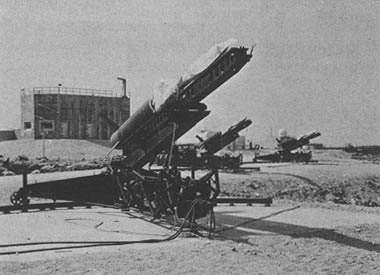Fort Churchill (rocket launch site)
Coordinates: 58°44′03″N 93°49′13″W / 58.73417°N 93.82028°W
Fort Churchill is a rocket launching complex located in Churchill, Manitoba. The site has been used on and off since the mid-1950s for sub-orbital launches of various sounding rockets for several studies. The facility was some kilometres East of the now defunct military camp, Fort Churchill, and connected by an all-weather gravel road.
History
The complex was first built in 1954 by the Canadian Army to study the effects of auroras on long distance communications. The programme shut down in 1955, but the site was re-opened and greatly expanded in 1956 as part of Canada's participation in International Geophysical Year. Launches for the IGY experiments started in 1957, and the site was closed again in December 1958 when the IGY, which was actually two years long, ended.
The site was reopened again in August 1959 by the US Army as part of its network of sounding rocket stations. In September 1959 it was used to test CARDE's new solid fuel propellant systems with PVT-1, the vehicle that would evolve into the Black Brant. However, in late 1960 a fire destroyed many of the facilities. It was announced that the Black Brant test series would be continued with an additional twelve launches at NASA's Wallops Island during 1961-62, while the facilities at Churchill were rebuilt.
The US Army ended its involvement at Fort Churchill in June 1970, and the site was taken over by the Canadian National Research Council to support the Canadian Upper Atmosphere Research Program. The site was used sporadically during the 1970s and 1980s, and was inactive by 1990.
After 1985 the facility was largely deserted. Nearby, however, at the site of Fort Churchill and the town of Churchill were an airport, a railway, some offices (Chamber of Commerce office), an eco-tourism centre and a geomagnetic observatory. Over the years over 3,500 sub-orbital flights were launched from the site.[1]
In 1995 Akjuit Aerospace, a private company, announced it would spend $300 million to develop the site as Spaceport Canada, offering it as a commercial site for polar sounding rocket launches.[2] The company signed a 30-year lease for the old Churchill rocket test site in 1994, and put together a "technical team" of 21 firms led by the American aerospace contractor Raytheon.[2] In 1996 they signed an additional deal with the STC Complex of Russia.[2] to launch commercial polar-orbiting loads on surplus Soviet-era SS-25 ICBMs which were being re-purposed as small orbital launchers known as START-1 (so named as they were made surplus by the START treaty). Churchill's location in the "western hemisphere" combined with its range-safety for firing northwards made it an ideal location, with the exception of the extremely cold weather which would limit launch seasons. Akjuit Aerospace closed down operations in May 1998 due to a lack of financing and the collapse of the space launch market in 1999/2000.[2]
-

Nike rocket ready for launch from Fort Churchill. Photo taken between 1960 and 1964.
References
- ↑ CSA - Fort Churchill – a landmark in Canadian space research
- 1 2 3 4 Braga, Matthew (September 25, 2014). "The Failed Plan to Build a Commercial Spaceport in the Subarctic". Motherboard. Retrieved 2016-04-15.
